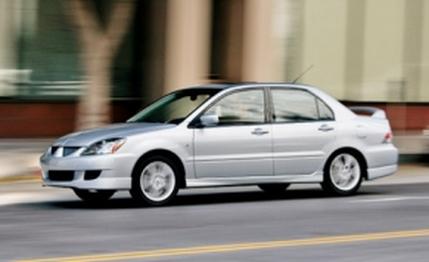
 First Drive Review
First Drive Review
Mitsubishi established its motorsports arm, Ralliart, in 1984 to ride herd over its rally racing. Since then, Ralliart-modified Lancers competing in the World Rally Championship (WRC) have claimed one manufacturers' title and four drivers' titles.
Consequently, Ralliart has become a household name in lands such as Finland and Australia-two stops on the WRC circuit-but not in the U.S., where the WRC exists only on TV and video screens. Subaru faced a similar recognition issue with its motorsports wing, Subaru Tecnica International (STi)-a Ralliart foe in the WRC (although not this year, since Mitsubishi is taking a one-year hiatus)-and remedied it earlier this year with the U.S. intro of the Impreza WRX STi, a 300-hp rocket good for 0 to 60 in 4.6 seconds ("New-Wave Slingshots," June 2003). Now do you know STi? Of course, in that comparison test, the swift Subie lost to the less-swift, more-fun 271-hp Mitsubishi Lancer Evolution, a car on which the Ralliart WRC machine is based.
Rather than introduce Ralliart to us via the conquering Evo, Mitsubishi is instead choosing two Lancers making more than 100 less horsepower than that Evo. Curious? Indeed. But after a day driving the Lancer Ralliart sedan and Lancer Ralliart Sportback wagon around Southern California, it's clear Mitsubishi's in-house tuner has done plenty to justify its renowned name.
The Lancer Ralliart is really what the 120-hp Lancer O-Z Racing Rally Edition should have been in the first place-a legitimate sport compact that is quick, nimble, and capable of taking on the likes of the Ford SVT Focus and Mazdaspeed Protegé. Beneath the Ralliart's newly sculpted hood (all '04 Lancers save the Evo get the fresh corporate face) is a highly modified version of the 4G64 2.4-liter SOHC four-cylinder engine that powers the current Eclipse and Galant. Code-named 4G69, the new engine uses a lighter iron block, a higher 9.5:1 compression ratio (from 9.0:1), a dual-port exhaust manifold (from a single), longer intake runners, and lighter valves, pistons, connecting rods, crankshaft, and rocker cover. Most notable is the installation of MIVEC, Mitsubishi's variable-valve-timing-and-lift system. Similar to Honda's VTEC system, MIVEC employs separate cam profiles for low and high engine speeds. But whereas VTEC uses two distinct cam profiles, MIVEC uses three-a high-lift, high-speed profile and low- and mid-lift, low-speed profiles, which, according to Mitsubishi, better induce swirl in the cylinders for improved combustion and emissions. All that wizardry nets 162 horsepower and 162 pound-feet of torque, putting it lower on power than the 170-hp Focus and Protegé, but higher on torque by 17 and 2 pound-feet, respectively.
The engine resonates with a buzz that is more pleasing than annoying, even when MIVEC switches to the high profile at 3500 rpm or when the needle plays tag with the 6500-rpm redline. Throughout the rev range, the engine demonstrates a smooth, effortless demeanor reminiscent of Honda's 2.4-liter four-cylinder. Animated interaction with the throttle becomes addictive.
A five-speed manual is the standard dance partner to the MIVEC motor, with a four-speed automatic as an option. The manual features a beefed-up clutch, a triple-cone synchronizer for second gear, and linkage borrowed from the Evo. Shift and clutch effort is light, making Mitsubishi's decision to offer only the automatic in the Sportback an apparent oversight. Mitsubishi says the five-speed could find its way into the wagon if demand warrants it.
The manual-equipped sedan we drove felt satisfyingly quick and seems a fitting player in the pocket-rocket league. Our best acceleration guesstimates are 0 to 60 in 7.5 seconds and the quarter-mile in 15.7, which would squeeze it right between the Focus and Protegé.
Chassis upgrades from the O-Z Racing edition's standard catalog are extensive. Shock damping is up 150 percent in front and 85 percent in back, front spring rates are 20 percent stiffer, and the front anti-roll-bar rate is 17 percent higher. A three-point strut tower brace now resides above the engine and steering rack; the latter is retuned and loses its shimmy damper for less flex and better feedback. Brakes are discs all around, with 10.9-inch rotors up front, 10.3-inchers in back, and ABS is standard. Alloy wheels have grown from 15 to 16 inches in diameter and are fitted with V-rated 205/50R-16 Bridgestone Potenza RE92 rubber. Together, the results of these changes are immediately apparent-especially when the road curves and dips-creating a car with quick reflexes, a surprisingly compliant ride, and a lightness of movement similar to that in the SVT and Mazdaspeed. The Ralliart is an easy and fun car in which to toy with the limits of adhesion.
Changes in the cockpit include white-face gauges, faux-carbon-fiber trim on the dash, and supportive buckets pulled from the Japanese-market Evo GT-A. Options include side airbags, a sunroof, and a 315-watt Infinity sound system.
The Ralliarts are on sale as you read this, starting at about $18,000 for the sedan and $19,000 for the wagon. Wearing those reasonable price tags, Mitsubishi's new sport compacts should prove competitive, making quick work of the roughly 6500 Ralliart sedans and 6000 Sportbacks allocated for the first year.